
Pianist
Extracurricular Activities—
Classical Piano Performance Preparation—
Leschetizky to Raab to Krasoff to Heitman
The Juilliard School
Professional Background
→ Biography for Pianist, Steven HeitmanBiography: 1 2 3 4 5 6 7 8 9 10
Objectives
My primary focus and extremely super intense classical piano performance objectives are:To give my debut concert at Carnegie Hall in New York, attending Juilliard (or best-matched option) for successful and adequate professional preparation, based on an already approved substantial curriculum plan for a solid background only in classical piano performance.
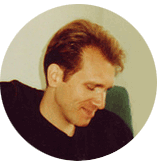
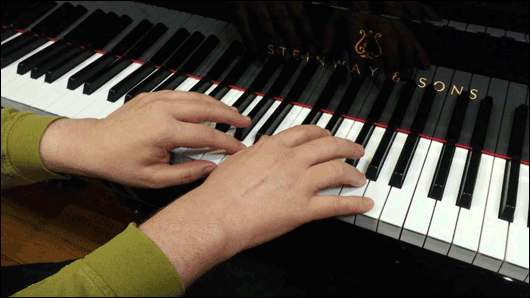
Steven Heitman—pianist—
a quick photo taken of my hands on the
Steinway B piano; October 19, 2017.
Previously, the long-term plan was established by my professor and other Juilliard professors (including Peggy Salkind, former Department Chair Piano at the San Francisco Conservatory of Music and Juilliard graduate) and my mom—that it would provide a lasting legacy and full career as a concert pianist. (If I could have had Arthur Rubinstein sign off on the curriculum plan, I would have done so.)
While Bach is one of my favorite composers, I really do not have any preference or favorite composers. Of course, I do adore Beethoven and Mozart, including a profound love for Chopin and Brahms. I enjoy every composer and all the different composers. In reality, every composer is my favorite composer.
My parents never forced me to take lessons or become a pianist. The truth is that I am the only driving force for being a pianist. I might add I was encouraged to be normal and get the usual university education, not in classical piano performance. I have always paid for my own lessons and education in classical piano performance. The many significant Juilliard influences at a very early age formed my professional opinions and attitudes, about my approach for classical piano performance. Though I do not see it as wrong or right, it is just how my life has always been. I cannot change that and would not for anything. Then I formed my own thoughts about what I do, because I am an original product. As in writing, I found my own voice. In music and playing piano, I found my own unique approach.
However, I agree with Arthur Rubinstein that in reality there are no methods. The pianist already has to have an inborn talent that can only be nurtured and guided and developed naturally. The curriculum plan is only a means to an end and serves as a guide. It helps to keep track of everything. Then no one forgets; this is how we get true results!
The Russian—The Leschetizky School—(5-year program taught in the Russian Conservatories of Music) technical regimen for the piano is a combined component that also includes the practical technical and artistic and classical piano performance application of Czerny, Chopin, Duvernoy, Tausig, Liszt, Joseffy, Plaidy, Brahms, Schumann (I tend to conceptualize superior phrasing, beautiful tonal qualities derived from the French School; influenced mostly by Arthur Rubinstein and my mom; German School; Die Schule der Geläufigkeit; Die Kunst der Fingerfertigkeit).
In the curriculum plan, Professor Krasoff and Professor Raab stressed the importance of being able to properly execute a polished technique in a fluid but firm manner, not in the old-school-velocity stiff technical style. A higher level of details more thought out in phrasing and producing a singing tone on the piano. My approach is always learning and performing by doing it and then making fair assessments.
“ During the first five years, the backbone of all the daily work in Russian music schools is scales and arpeggios. The pupil who attempted complicated pieces without this preliminary drill would be laughed at in Russia. ”—Josef Lhévinne, Pianist, Professor at Juilliard (1874-1944)
The Russian technical regimen program covers essential patterns found in advanced pieces for:
◼ Single note scales and chromatic scales (24 major/minor)
◼ Broken chords
◼ Arpeggios and blocked chords
◼ Scales in double notes (thirds, sixths, octaves)
◼ Similar and contrary motion combined (scales/arpeggios)
◼ Russian patterns with transitions
Establishment of—
The Heitman Foundation
It is also my goal and objective to establish The Heitman Foundation. Because so many wonderful gifts unfold in life, it would be suitable to develop and provide a fund that would give pianists with potential a full scholarship for classical piano performance. Of course, it is still a work in progress and eventually made available. Many of the great pianists only became successful, since they were financed by sponsorship from sponsors.I heard the story about Professor Raab that he took in a pianist with damaged hands, after he quit the conservatory of music. Let him live in his home rent-free. He gave him daily piano lessons at no cost. He assisted him to regain what he had lost, and the pianist became a very successful teacher. The difference between these professors is that they helped people without asking for anything, like money. In the long run, it produced results. It was his Christ-like presence in teaching that taught many pianists to be successful.
An original painting done by
the artist Carolyn Knee (in San Francisco, California)
for pianist Steven Heitman.
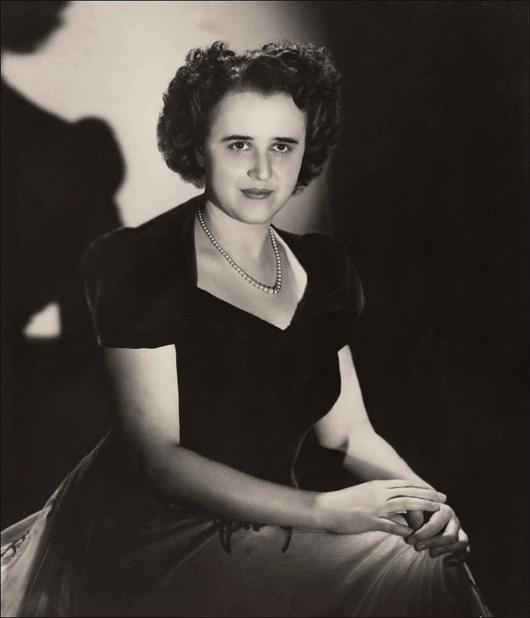
Steven Heitman’s
Classical Piano Performance
Professor Wanda Krasoff
(PR photo from 1940s);
my professor prepared a few talented
pianists for Rosina Lhévinne at Juilliard.
I was one of her very last students—very
grateful, fortunate, and lucky!
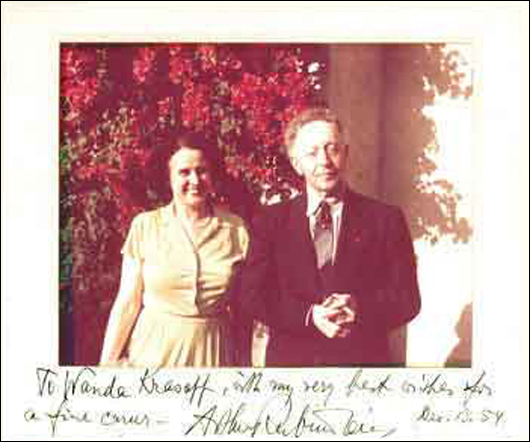
It was a most glorious day and time
for my Professor Krasoff, to perform
for Arthur Rubinstein and hear
his words of wisdom.
To Wanda Krasoff, with all my best wishes for a fine career.
Arthur Rubinstein
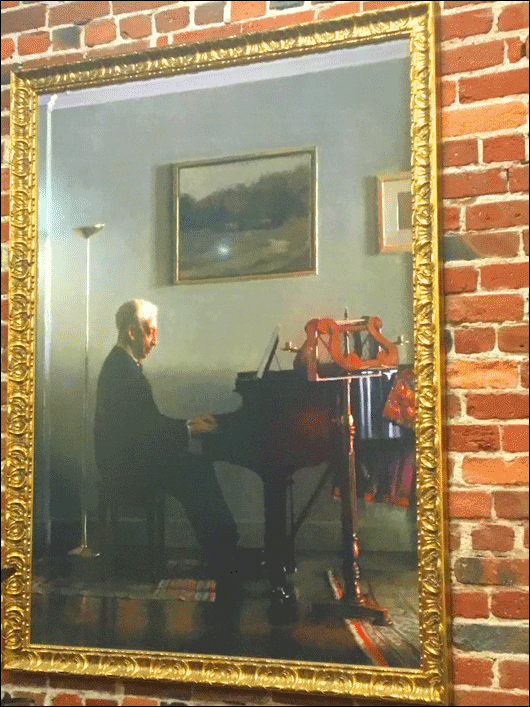
This painting is a superb and contemporary
likeness of Arthur Rubinstein.
I enjoyed the day, looking at Steinway grand pianos and noticed this painting on the wall; it spoke to me.
Pianistic Background—
Lineage
Being linked via Alexander Raab—her Professor, Wanda Krasoff—my Professor—to a tradition that descended directly from Ludwig van Beethoven himself, handed down through Carl Czerny, and Theodor Leschetizky, including Franz Liszt (her technical approach was more akin to the Siloti-Liszt method—specific to her remarkable technique that she emphasized and taught to her students); Alexander Raab studied with Leschetizky at the Vienna Conservatory and was acquainted with Brahms.I am very thankful and grateful to Wanda Krasoff, pianist. She was my primary classical piano performance Professor, including many other Juilliard-trained pianists (as well as my mom) as well as Liszt Academy-trained (Sari Biro and her assistant) classical piano performance Professors.
She was reviewed by Harold C. Schonberg, Miles Kastendieck, The New York Times, New York Herald Tribune, Ignace Paderewski (Rancho San Ignacio), Josef Hofmann (Curtis Institute), Arthur Rubinstein (Los Angeles).
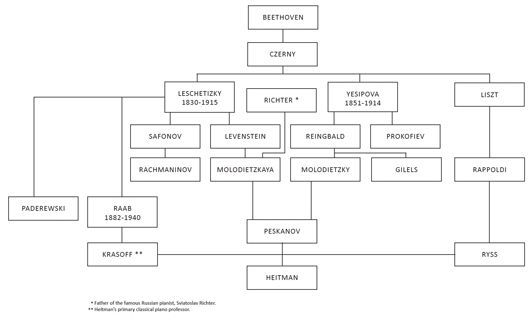
Musical Family Tree for
Pianist
Steven Heitman
◼ The Leschetizky School
Steven Heitman
Pianist
Copyright © 1998-2027
All rights reserved
Updated: March 1, 2022